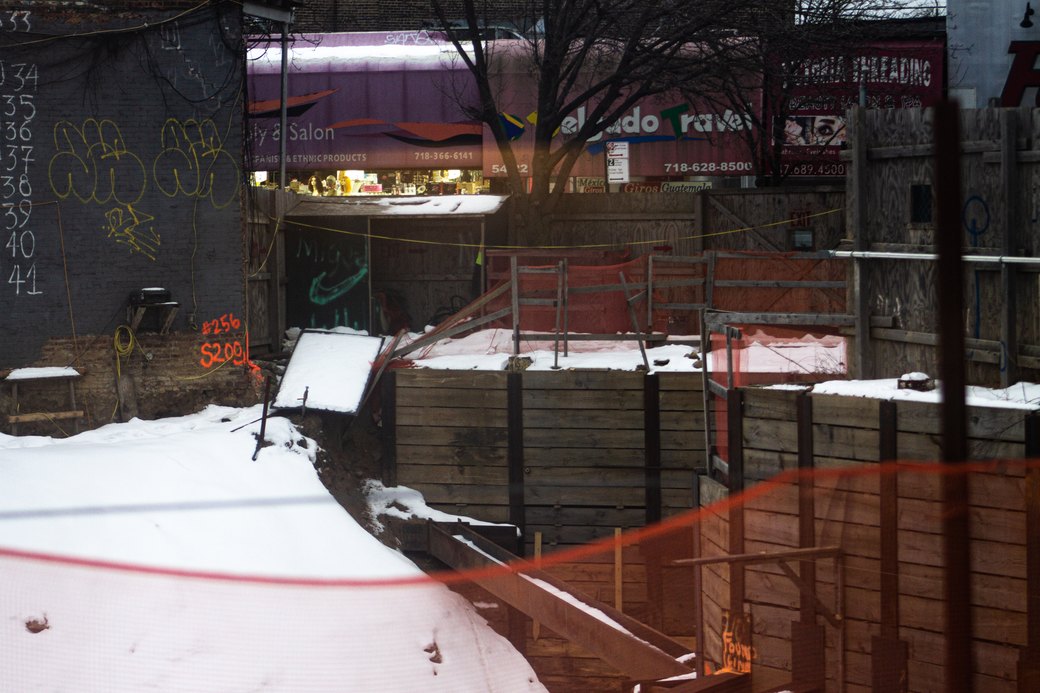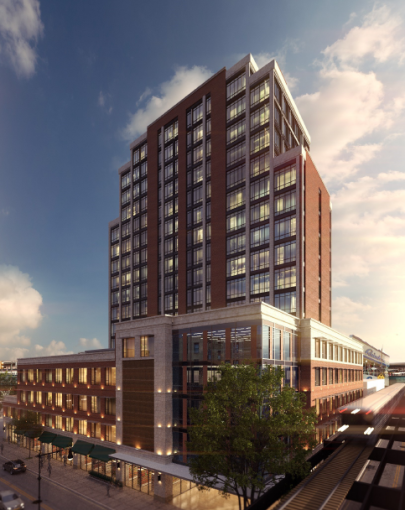A 17-story building is set to be built on the border of Ridgewood and Bushwick next to the Myrtle/Wyckoff station. The building, which will be the tallest in Ridgewood and sit on almost an entire acre of land, is yet another soaring apartment complex rising out of the Ridgewood and Bushwick area.
Last week, Madison Realty Company announced it was investing $106 million into the newly-rebranded Myrtle Point project (previously known as “Ridgewood Tower”) and which remains spearheaded by developers Arch Companies and AB Capstone. The upper 13 floors will include 133 residential units, and the first four floors will be leased to “two big box credit retailers.”
Across the street from the construction site is a liquor store, a storefront selling carpets, and a supplement shop. The only big national retailer nearby is a Rite Aid a block away. Many of the small businesses that line the surrounding blocks are taquerias and Dominican joints and when contacted by Bushwick Daily, most said they did not know about the tower. There’s also a smattering of laundromats, bodegas, and salons, but if you walk a few blocks in any direction away from the nearby elevated train track you can find a trendy clothing or vintage store.

Some local business owners, who declined to be identified, said they were feeling cautiously optimistic about the prospect of new big box competitors across the street.
“I think that having something like a Target in the neighborhood would be beneficial as a business owner just because it’s going to bring people to the neighborhood, there’s going to be more foot traffic,” said the owner of a local bar and coffee shop. “People that live in the neighborhood, they’re going to be looking for spots like us, for places to hang out and places to just patron.”
The owners of a local pharmacy a few blocks away from the construction site, both of whom have spent their entire lives in Queens, echoed a similar sentiment in regard to their value as a small business. “The service we provide will never be provided by a big chain. I don’t see it as a competition.”
“You would lose your customers because they’re moving out, not because they’re going to the chain,” the pharmacy owner continued.
“It drives the people that were already living there out of the area, and the small businesses, too. They can no longer keep up with the rent. You’ve seen Myrtle Avenue, it’s all empty, it’s all for rent.”

A longtime resident of the Bushwick and East Williamsburg border remembers the start of the neighborhood’s gentrification in the early 2000’s a bit differently. “Kids were coming out of college and wanted to have a Brooklyn address. We couldn’t believe we were on the radar.”
“Then we started to see bars and restaurants, little shops, coffee shops opening up in the neighborhood; it was blooming. We were looking forward to the new place that was opening up next.” She talked excitedly about when artists moved to the area and the exhibits that popped up, then about the movement of young professionals to the area.
“The downfall was that the bodegas were closing. Then we noticed the interest from developers on building and converting the factories into apartments.” She went on to talk about how her mother had worked in a factory on Onderdonk Avenue for years. “Now there are a lot of buildings coming up, some junk yards turned into apartment buildings.”
Unlike the warehouses in western parts of Bushwick, Ridgewood has always felt domestic, served by an established network of small businesses on its main streets.

In a 2016 televised interview with real estate developers including Meir Babaev, the AB Capstone developer of 3-50 St. Nicholas Ave., it was this very characteristic — as well as Ridgewood’s proximity to the L and M train lines — that was named as a reason why Ridgewood provided a “natural progression” for developers following Williamsburg and Bushwick.
Non-profit and mutual aid organizations have been working to fight this. In September, the Ridgewood Tenants Union protested at the construction at 3-50 St. Nicholas outside the home of the president of AB Capstone, Meir Babaev.
The tenants union wrote in a statement: “Working class tenants and tenants of color are alarmed by the harm this project will cause as luxury development drives up rents in a neighborhood where they are already struggling and they are outraged at the total disregard Babaev has shown the Ridgewood community.”
Several of these apartment buildings have already been built in Bushwick in the last few years, like the Rheingold at 10 Montieth St., the Denizen X at 123 Monteith St., or a highly publicized 7-story building that went up at 1595 Broadway. Even more permits have been filed for similar buildings. Most notably, a now infamous 20-story building is going up on the site of a former community garden, which was covered by The Bushwick Daily. These types of buildings are no longer an anomaly in Ridgewood and Bushwick.
“The problem with Bushwick is that it has an older zoning designation that lets you go tall if you have open space around your building,” said Christopher Walters, a Land Use Policy Coordinator at the Association for Neighborhood Housing and Development, a non-profit that among other initiatives, advocates for affordable housing and fights displacement. Walters said this open space can often end up meaning parking.
“What it’s resulted in in Bushwick are these kinds of towers that stand in stark contrast to their neighbors. And then stand in stark contrast in terms of their rents and who they’re serving.”

Bushwick’s population has grown 15% since 2000, more than double the citywide average, a situation that inevitably leads to hikes in rent. “One of the issues in Bushwick is that its zoning allows towers, sort of out of context development, with no requirement that they need to require affordable housing,” said Walters.
After the city’s rejection of the Bushwick Community Plan last year, affordable housing in Bushwick and Ridgewood continues to fall under the minimum required in Mayor de Blasio’s 2016 Mandatory Inclusionary Housing, which applies only to lots that are being rezoned.
At 3-50 St. Nicholas Avenue, the 17-story building did not require rezoning, so the Mandatory Inclusionary Housing policy did not apply.
Nonetheless, the new press release sent out by financier Madison Realty Capital stated that 30% of the building’s units will be affordable. Developers are incentivized to include affordable housing because they can either receive state subsidies or qualify for a tax abatement under 421a property tax exemption.
“One of the issues with programs like 421a is that what’s defined as affordable housing can be defined very high, and I think you see a good amount of that in Bushwick,” said Walters.
The target income level for affordable housing, which is calculated as a percentage of area median income or AMI, can vary. Often, households that make more than the local AMI qualify for affordable housing units.
Last year, affordable housing units at the building, back when it was called Ridgewood Tower, began offering affordable housing to households earning 130% of the AMI, according to a report by the New York real estate website CityRealty. At 387 Bleecker Street in Bushwick, a six-story apartment complex built in 2018, an affordable housing lottery opened up this January, which also offered its affordable housing units at 130% of AMI. According to the city’s affordable housing office, this meant that its units were available to households making from $68,160 to $159,640 per year
In Bushwick, the area median income in 2018 was $54,240, according to the NYU Furman Center.
However, AMI as it applies to affordable housing is not calculated by neighborhood. The federal government determines the median income for an area, and New York City’s AMI includes wealthy suburbs like Westchester as well as all of Manhattan.
“If it was actually pegged for Bushwick, it would be better for Bushwick residents,” said Walters.
The target income level for the affordable housing units at 3-50 St. Nicholas Ave. has not yet been disclosed. Some reports of the building say that it will include a gym, on-site parking, and common outdoor areas; the building could perhaps be defined as a luxury complex. If completed, it would be one of the first of its kind in Ridgewood and will undoubtedly bring a new demographic to the area.
“Ridgewood is a mix of everything, I love the mix,” the owner of the local pharmacy said. “You have Spanish people, you have Polish, you have some Eastern Europeans, and now you have a lot of young people, so it’s cool. The big development I don’t like. Out of everything else, it sticks out.”

Top photo credit: Andrew Karpan
For more news, sign up for Bushwick Daily’s newsletter.
Join the fight to save local journalism by becoming a paid subscriber.


